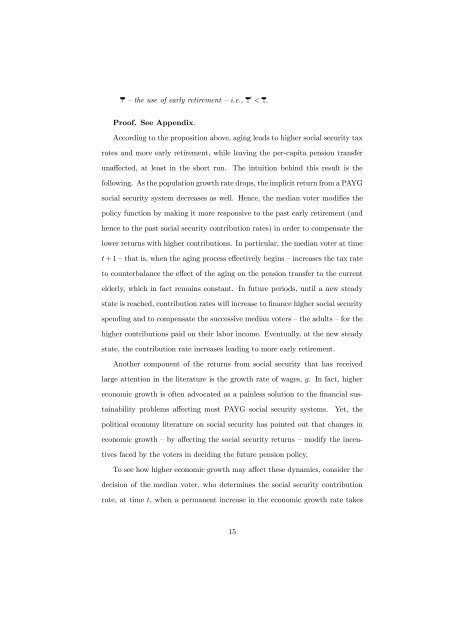The Evolution of Retirement by J. Ignacio Conde-Ruiz* Vincenzo ...
The Evolution of Retirement by J. Ignacio Conde-Ruiz* Vincenzo ...
The Evolution of Retirement by J. Ignacio Conde-Ruiz* Vincenzo ...
You also want an ePaper? Increase the reach of your titles
YUMPU automatically turns print PDFs into web optimized ePapers that Google loves.
τ — the use <strong>of</strong> early retirement — i.e., z 0 < z.<br />
Pro<strong>of</strong>. See Appendix.<br />
According to the proposition above, aging leads to higher social security tax<br />
rates and more early retirement, while leaving the per-capita pension transfer<br />
unaffected, at least in the short run.<br />
<strong>The</strong> intuition behind this result is the<br />
following. As the population growth rate drops, the implicit return from a PAYG<br />
social security system decreases as well. Hence, the median voter modifies the<br />
policy function <strong>by</strong> making it more responsive to the past early retirement (and<br />
hence to the past social security contribution rates) in order to compensate the<br />
lower returns with higher contributions. In particular, the median voter at time<br />
t + 1 — that is, when the aging process effectively begins — increases the tax rate<br />
to counterbalance the effect <strong>of</strong> the aging on the pension transfer to the current<br />
elderly, which in fact remains constant. In future periods, until a new steady<br />
state is reached, contribution rates will increase to finance higher social security<br />
spending and to compensate the successive median voters — the adults — for the<br />
higher contributions paid on their labor income. Eventually, at the new steady<br />
state, the contribution rate increases leading to more early retirement.<br />
Another component <strong>of</strong> the returns from social security that has received<br />
large attention in the literature is the growth rate <strong>of</strong> wages, g. In fact, higher<br />
economic growth is <strong>of</strong>ten advocated as a painless solution to the financial sustainability<br />
problems affecting most PAYG social security systems.<br />
Yet, the<br />
political economy literature on social security has pointed out that changes in<br />
economic growth — <strong>by</strong> affecting the social security returns — modify the incentives<br />
faced <strong>by</strong> the voters in deciding the future pension policy.<br />
To see how higher economic growth may affect these dynamics, consider the<br />
decision <strong>of</strong> the median voter, who determines the social security contribution<br />
rate, at time t, when a permanent increase in the economic growth rate takes<br />
15






